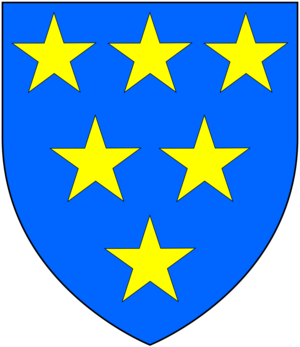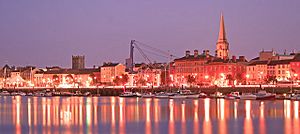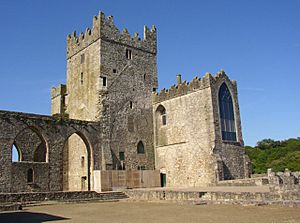Nicholas Walsh (judge) facts for kids
Sir Nicholas Walsh (born 1542, died 1615) was an important Irish judge, politician, and landowner. He lived during the time of Queen Elizabeth I and King James I. He was the Speaker of the Irish House of Commons in the Irish Parliament from 1585 to 1586. He was also a close friend and helper of Sir John Perrot, who was the Queen's main representative in Ireland, called the Lord Deputy.
Even when Sir John Perrot faced problems, Nicholas Walsh quickly got back his influence. This was because he was very loyal to the English Crown (the King or Queen of England). Queen Elizabeth I herself thought highly of him.
In 1597, he became the Chief Justice of the Irish Common Pleas, which is a very high court position. He was also part of the Privy Council of Ireland, a group of advisors to the monarch. His loyalty was so strong that he was attacked during a riot in his hometown of Waterford in 1603, but he managed to escape. It was quite unusual back then, but he was elected as a Member of Parliament (MP) while also serving as a high court judge.
Nicholas Walsh became very rich and was known as "the richest commoner" (meaning a person not of noble birth) in Munster, a region in Ireland. He was also interested in traditional Irish culture. A famous Irish poem, Labhrann ar Iongaibh Éireann, was even written for him.
Contents
Early Life and Family
Nicholas Walsh was born in Waterford, a city in Ireland. His father, James Walsh, was the Mayor of Waterford twice. His grandfather, Patrick Walsh, was also Mayor of the town.
Nicholas's father died when Nicholas was young. He and his sister, Johanna, were then looked after by Thomas Butler, 10th Earl of Ormond. The Earl sent them to live with Nicholas White, who later became a top legal official in Ireland. The Walsh family was already wealthy, which helped Nicholas build his large fortune. He began studying law in London in 1561.
His sister, Johanna, married Gerald Comerford. Gerald was also a trusted official and a judge, just like Nicholas.
Starting His Career
Nicholas Walsh's first official job was the Recorder of Waterford, a legal role he held for his entire life. After a major land settlement in Munster, he was one of three people in charge of governing that region. He was known for gaining a lot of land that used to belong to rebels, which made him even richer. He owned land in County Cork, County Kilkenny, and Kinsalebeg in County Waterford. His lands in Clonmore, County Kilkenny, were a main source of food for Waterford city.
In 1570, Walsh became a judge in the Provincial Court of Munster. By 1576, he was promoted to Chief Justice of Munster.
In 1587, Queen Elizabeth I appointed Walsh to the Privy Council, a group of important advisors. This showed how much Sir John Perrot and the Queen trusted him. The Queen herself wrote that she believed he had "discretion, wisdom, and fidelity" and was "meet to be one of our Privy Council."
It was unusual for a sitting judge to also be a member of the House of Commons, but it happened a few times in Ireland. Nicholas Walsh had the Queen's full support for this. She praised his good work as both Chief Justice of Munster and a judge in the Queen's Bench.
His Time as a Judge
Nicholas Walsh's close ties to Sir John Perrot made Adam Loftus, another powerful official, dislike him. When Perrot lost his power in 1588, Loftus tried to harm Walsh's career too. Walsh was almost charged with helping to wrongly convict Perrot's former secretary. However, with the help of friends, he avoided trouble and quickly regained his influence.
He was considered for another high judicial position but was passed over, possibly because he was Irish-born. It was generally understood that Irish-born judges usually served in the Court of Common Pleas (Ireland). So, in 1597, Walsh became the Chief Justice of that court and was also made a knight.
He was a very dedicated judge. At a time when many judges avoided traveling to hold court sessions (called assizes), Walsh was very diligent, even when he was in his late 60s. In 1600, he even stepped in as Chief Justice of Munster again because the actual Chief Justice was not doing his job.
Challenges in Waterford
During the Nine Years War (a conflict in Ireland), Walsh was cut off from Dublin and faced danger in 1599–1600. He faced more danger in 1603 when James I of England became king. A short rebellion broke out in some southern towns, aiming for more religious freedom for Catholics.
Walsh, as the Recorder, tried to convince the Waterford city council to declare James as King. But a riot started, and Walsh might have been killed if his relatives on the council had not stopped the violence. Even though Walsh had served the Crown loyally, he was not always popular in Waterford. Many people in the city supported the rebels.
The Cork Trial
A similar, more serious uprising happened in Cork. The Crown decided to make an example of the Mayor of Cork and the Recorder of Cork, William Meade. Meade remained defiant, so the Crown set up a special court to try him for treason (betraying the Crown).
Walsh and two other judges helped oversee the trial. However, the jury, even though mostly loyal Protestants, found Meade not guilty. This was a big problem for the Crown. Meade later proved the Crown's suspicions were right by fleeing to Italy.
By today's rules, Walsh should not have been a judge in Meade's trial. He had almost been killed in a similar rebellion in Waterford, so he could not be completely fair.
Later Years and Legacy
In 1605, Nicholas Walsh was asked to investigate the lands of a deceased knight. This document is now in the National Library of Ireland. In 1612, he was allowed to retire due to his health. He died three years later.
There is a story that Walsh converted to Roman Catholicism just before he died. It is said his funeral was held using Catholic traditions, which would have been embarrassing for the Crown he served so loyally. Later generations of his family mostly became Protestant, which helped them keep their lands.
Family and Property
Nicholas Walsh's main home was at Clonmore, County Kilkenny. But as "the wealthiest commoner in Munster," he owned many other properties, including in Kinsalebeg and Piltown. He married twice. His first wife was Catherine Comerford, and his second was Jacquetta Colclough. Jacquetta's father bought Tintern Abbey in 1575.
Sir Nicholas Walsh started the Walsh family line of Piltown, County Kilkenny. Because of his important roles, he gained a lot of land in Munster after the Desmond Rebellion in 1579.
He had at least one son, also named Sir Nicholas Walsh (1590–1643). This son is sometimes confused with his father. The younger Nicholas became a leader of Confederate Ireland during the Irish Rebellion of 1641. He died fighting to protect his property. His eldest son, Thomas, managed to keep much of the family's land by converting to Protestantism. The family continued to use "of Piltown" in their name until the late 18th century.
Supporter of Irish Culture
The poet Tuileagna Ó Maoil Chonaire wrote a poem called Labhrann ar iongaibh Éireann for Sir Nicholas Walsh. This poem told an old Irish story about a king's judgment. The fact that this poem was written for Walsh suggests that he not only spoke Irish but also had an interest in traditional Irish culture. He might have acted as a "patron," supporting Irish artists and writers.
His Reputation
Historians describe Walsh as a very successful politician and judge. They say his hard work and loyalty to the Crown helped him reach high positions, even though being Irish-born was often a disadvantage back then. Some suggest that his great wealth also played a big part in his success.
Images for kids







